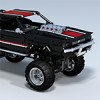
Custom Arduino lights/sound controller for automotive LEGO builds
By
VintageCharlie, in LEGO Technic, Mindstorms, Model Team and Scale Modeling
-
Recently Browsing 0 members
No registered users viewing this page.
